The art of aeons

WE BEGIN TO RISE and I watch the landscape below becoming smaller. I look down and see markings – white on black; clusters of shapes I recognise as belonging to the rich-yet-sparse aesthetic of Lena Nyadbi, a Gija Aboriginal artist of Western Australia’s East Kimberley region. But I’m not in Australia: this is Paris, and I’m in a lift ascending the Eiffel Tower.
Sprawling beneath, and covering the rooftop of the Musée du quai Branly, is a 700sq.m artwork called Dayiwul Lirlmim (Barramundi Scales). It’s 46 times larger than the ochre and charcoal original and a powerful affirmation that contemporary Aboriginal art is now solidly grounded within the international art world. Ten large-scale contemporary Aboriginal artworks are on permanent display at the museum – a collaborative effort of the French and Australian governments that’s hailed as the most important installation of indigenous art outside of Australia. There was further proof last year of the status of contemporary Aboriginal art on the walls at the 56th Venice Biennale, the art world’s most prestigious contemporary exhibition. In fact, 2015 was a record year for indigenous Australian participation, with work by Emily Kame Kngwarreye (1910–1996) included in the Biennale’s headline exhibition, entitled All the World’s Futures, while another 30 of Emily’s indigenous peers were in the official program.

The Musée du quai Branly is located beside the Seine and beneath the Eiffel Tower. The tower is the only place from where the museum’s largest work, Dayiwul Lirlmim by Western Australian artist Lena Nyadbi, can be seen. (Image credit: Frances Mocnik)
Wally Caruana, the National Gallery of Australia’s former senior curator of Aboriginal and Torres Strait Islander Art, says that contemporary indigenous art is the only internationally significant art movement to have emerged from Australia. It has evolved from the creativity of the world’s oldest continuous living culture to explode onto the world stage. But not only has this innovative art form gained international recognition as a formal movement, it has also generated a new field of academic study and new economy – the Aboriginal art market.
Yet within its own country, Aboriginal art has for many decades remained shackled to stereotypes and shrouded by misconceptions and prejudice. Despite this, today’s artists continue to express their connection – in both traditional and innovative ways – to country and culture. Engaging with a diverse range of artistic processes, the current generation of artists is finding new methods of expression, challenging stereotypes and reaching out to audiences.
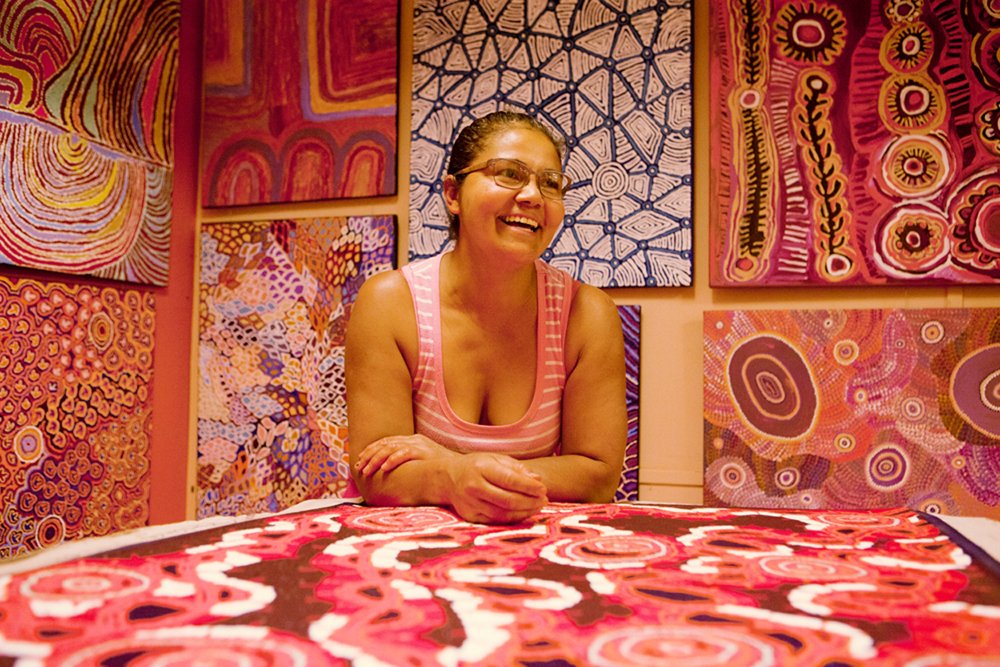
Gloria Morales is the assitant manager of the Warlukurlangu Artists centre, located in Yuendumu, 290km north-west of Alice Springs. Famous for its bright works of art and opened in 1985, Warlukurlangu is among the oldest and most successful Aboriginal-owned art centres in the Red Centre. (Image credit: Frances Mocnik)
Art historians generally agree that the origins of the contemporary Aboriginal art movement can be traced to the remote Central Desert community of Papunya, 245km north-west of Alice Springs, in 1971. Here, artist and public school teacher Geoffrey Bardon observed students making ground drawings of traditional motifs and suggested they paint them on the school wall. The idea sparked interest among community leaders who deemed the project too important for children and produced the painting themselves.
Transposing a series of circles and U shapes – motifs associated with cultural knowledge – onto the school wall, the Elders created what has come to be known as the Honey Ant Dreaming mural, a permanent record of what had otherwise been ephemeral markings on the ground or human body.
This mural was a catalyst for others in the Papunya community to begin painting other traditional designs onto fixed, portable boards and canvases. From this grew an international art movement, and a style of painting known as Western Desert Art – considered both the genesis of the Aboriginal contemporary art movement, as well as one of the most significant developments to emerge from it.
LOOKING DOWN ON Lena’s work from the Eiffel Tower my mind is drawn back to a small community in WA. Amid the chatter of tourists, Lena’s voice echoes in my ear, whispering the story immortalised in the artwork below.
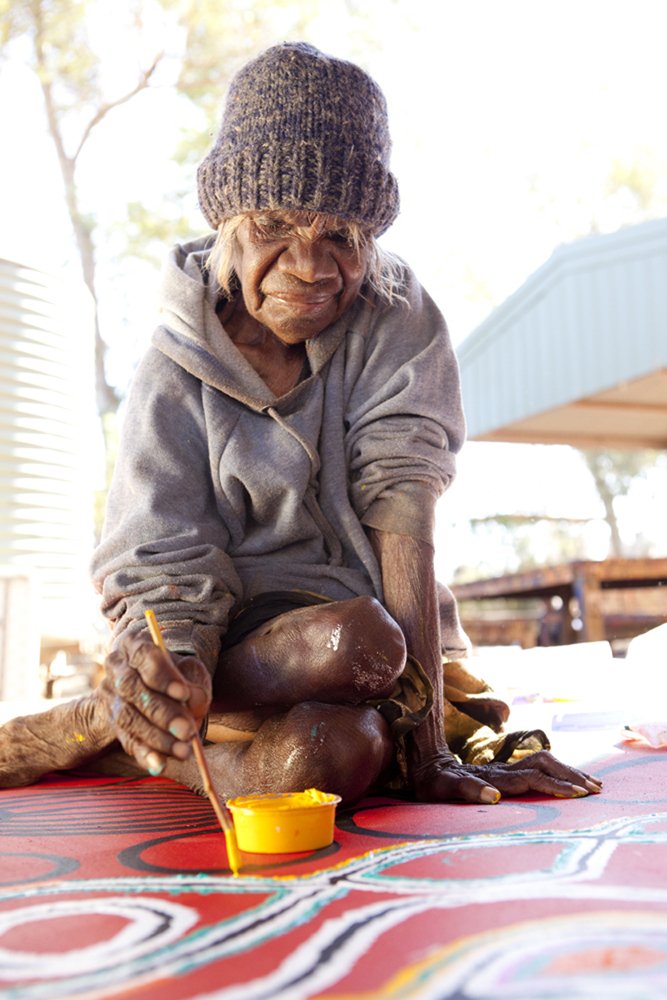
Senior Walpiri artist Judy Napangardi Watson, from the Yuendumu community and aged about 80, places her canvases on the ground and climbs atop to paint them, akin to the traditional approach of desert artists who painted while sitting on the ground. Using a twig to apply acrylic paint, Napangardi’s complex compositions are created by the rapid application of dots that overlap to form lines. (Image credit: Frances Mocnik)
“Them barramundi ready to jump off and swim home,” Lena said of the rooftop installation when I met her not so long ago on a hot, dry spring morningat the Warmun Art Centre roughly 15,000km east of Paris and 3000km north of Perth. Seated at her painting table, Lena stirred a pot of white ochre, loaded her brush and sank low in her chair – her eyes almost level with the canvas. In the stillness of the morning I sensed her shift in expression: the artist had entered the zone and as brush met canvas, sophisticated artistic and cultural knowledge combined in a creative outpouring.
She was painting her Ngarranggani – the Gija ancestral law of which she is a custodian and that she interprets in her art. The Ngarranggani– Tjukurrpa in the language of the Warlpiri or the Dreaming in western words – is a series of narratives used by Australian Aboriginal people to describe the journeys of ancestral beings who created land, people and culture. Passed down orally in story form, the Dreaming is an expression of this ancient living culture, retold in the present day by contemporary custodians of the storyline. Through these narratives, Aboriginal people maintain a deep connection to ancestors and Country.
Artists paint their Dreaming to evoke, remember or comment on their Country – land to which many no longer have access. With each painting, artists take a conceptual journey to renew connections to Country and culture. The shapes on Lena’s Paris installation are abstract representations of barramundi scales lost during a struggle between a large fish and two women trying to catch it. The barramundi escaped and, according to this Ngarranggani, the dislodged scales scattered across ancestral Gija country, becoming diamonds. Now home to one of the world’s largest diamond mines, the land has been torn up to reach these precious deposits, Lena lamented to me.

Iris Bendor, manager of Ngurratjuta Iltja Ntjarra /Many Hands Art Centre in Alice Springs, holds up the work of Benita Clements, the great-granddaughter of Albert Namatjira. (Image credit: Frances Mocnik)
By recording their lives and times, artists offer glimpses into other worlds. Works by indigenous artists are often created in response to contemporary issues and have been used to capture different histories, document experiences and advance political and social change. Notable among numerous examples are the collective paintings of the Pila Nguru, or Spinifex People (see AG#116). These artworks depict ancestral lands from which they were forcibly evicted in the 1950s to clear space for British nuclear testing. Visually complex, the paintings can be read as symbolic topographical maps and were successfully used as evidence in support of the group’s 1996 Native Title land claim.
At the Warmun Art Centre, I also found Shirley Purdie painting in the shade of the verandah. Artists here are known for their use of natural ochre and pigments on canvas and contemporary expression of land and culture. Many of these people are considered at the forefront of the contemporary Aboriginal art movement. “I’m painting bush medicine stories handed down from the old ones,” Shirley told me.
Her collection, already 53 canvases and growing, ambitiously aims to document the spectrum of bush food and medicinal plant varieties in Gija Country. She works on small canvases, her distinct style characterised by detailed and delicate motifs painted in a thick application of ochre, creating a heavily textured canvas and the visual appearance of topographical contours. As well as being compositional components, the motifs are symbols with meanings that can be understood in a manner similar to iconography. Decoding and understanding the messages painted into Aboriginal art offers a portal into other worlds and can provide a deeper understanding of an entire culture and continent.
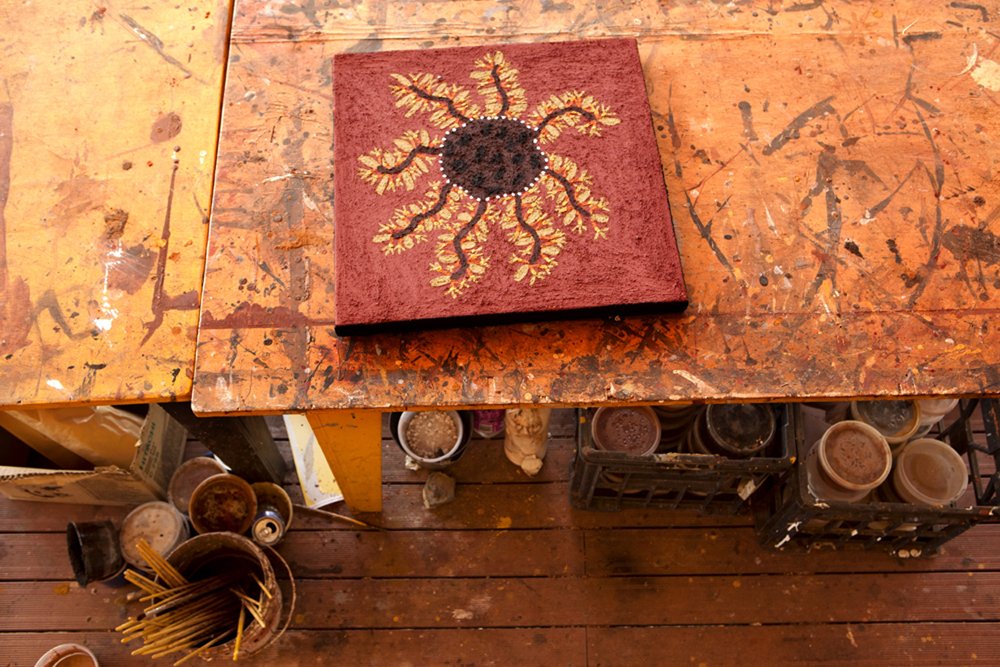
Shirley Purdie’s latest work in progress at Warmun Art Centre in the East Kimberley. Her current series depicts plant varieties found on Gija Country. A book showcasing this art will be published with explanatory text in both English and the critically endangered Gija language – an important contribution to the documentation of culture. (Image credit: Frances Mocnik)
“We are so lucky that artists allow us to look into their worlds,” says Angus Cameron, a director of Darwin gallery Nomad Art, explaining they provide a different understanding of landscape and Country. “It’s an amazing privilege for us non-indigenous people to gain those understandings of land. For so long, much of Australia has been regarded as ‘the alien landscape’. Indigenous people have taken us inside that landscape – it’s a really beautiful relationship.”
Symbols within Aboriginal art can express layers of complex meaning and communicate sophisticated systems of knowledge. Even non-experts can learn to recognise basic symbols that represent animals, people and objects, or simple narratives describing aspects of hunting or Creation stories. Greater significance is reserved for community members or custodians of storylines who are initiated into these deeper meanings, while an even higher level of understanding may be accessible only to senior lawmen, law-women or even just the artists themselves.
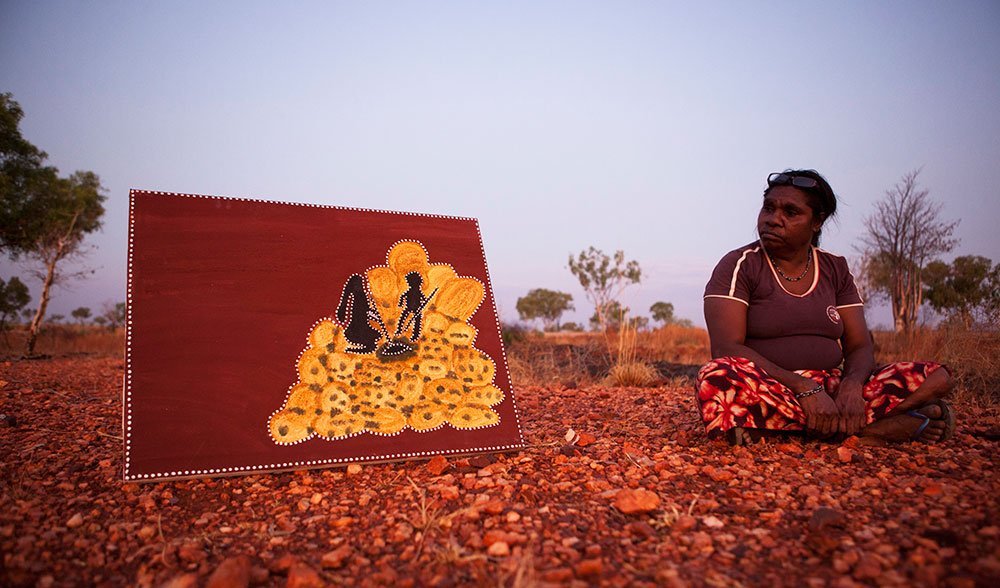
Kathy Ramsey, pictured, is the daughter of senior Gija artists and Elders Mona and Rammey Ramsey and among the next generation of artists honing skills at Warmun Art Centre. (Image credut: Frances Mocnik)
By using modern materials to paint traditional symbols on boards and canvases, Aboriginal artists are transposing ancient cultural knowledge into a new form of artistic language to create one of the most significant art movements of our time. It was the early artistic winds of change blowing in hot from the Western Desert that piqued the interest of Philippe Peltier, head of the Oceania-Insulindia Heritage Unit at the Musèe du quai Branly. Standing in front of the gallery’s Australian Aboriginal collection, he recalls when rumours of an innovative style began to emerge from Central Australia’s deserts.
“Coming from a contemporary art background, we understood that something was happening,” he says. “We were used to identifying artists who were going to be interesting – who were coming together conceptually and aesthetically in a new way.” By the time Philippe and his team had organised a buying trip, works of interest had begun to emerge from the remote community of Yuendumu.
The art centre trail
WITH MORE than 100 art centres dotted across Australia, visiting an Aboriginal-owned and -operated centre can be a rewarding way of experiencing and learning aboutart within the context, and landscape, in which it is produced. Art hubs, such as Alice Springs, have established routes that take visitors to a range of accessible town-based art centres. If you prefer to visit remote centres, check websites for instructions because many require permits and some are not open to the public.
LOCATED 295km north-west of Alice Springs and 100km north of Papunya, Yuendumu is home to a distinctive painting style that emerged in the 1980s and is characterised by precisely plotted dots and an exuberant palette.
A large sign at the turn-off to Warlukurlangu Arts Centre declares visitors are always welcome. On the day I visited it was a riot of colour, sound and activity. Artists of all ages milled around, some looking through art books, others waiting to register their finished works in the centre’s database. A group of international volunteers filled paint pots and primed canvases while all around walls were cloaked in finished pieces that reverberated with iridescent colour and narratives.

Two-way toyota by Dianne Ungukalpi Golding at the Desert Mob exhibition at Alice Springs’ Araluen Arts Centre. (Image credit: Frances Mocnik)
Indigenous-owned and -operated centres such as Warlukurlangu, established in 1985, are vibrant cultural hubs of self-determination that, as well as being places to create art, also foster intergenerational cultural learning. They offer employment and provide broader services that contribute to the wellbeing of entire communities. Importantly, these professionally managed businesses facilitate ethical dealings between artists, buyers and the art industry.
Traditional stories are now being told within the context of the contemporary gallery, said Nici Cumpston, director of Tarnanthi, the inaugural Festival of Contemporary Aboriginal and Torres Strait Islander Art, held in Adelaide in October 2015. Tarnanthi was an ambitious endeavour that brought together more than 500 new and established artists from across the country.
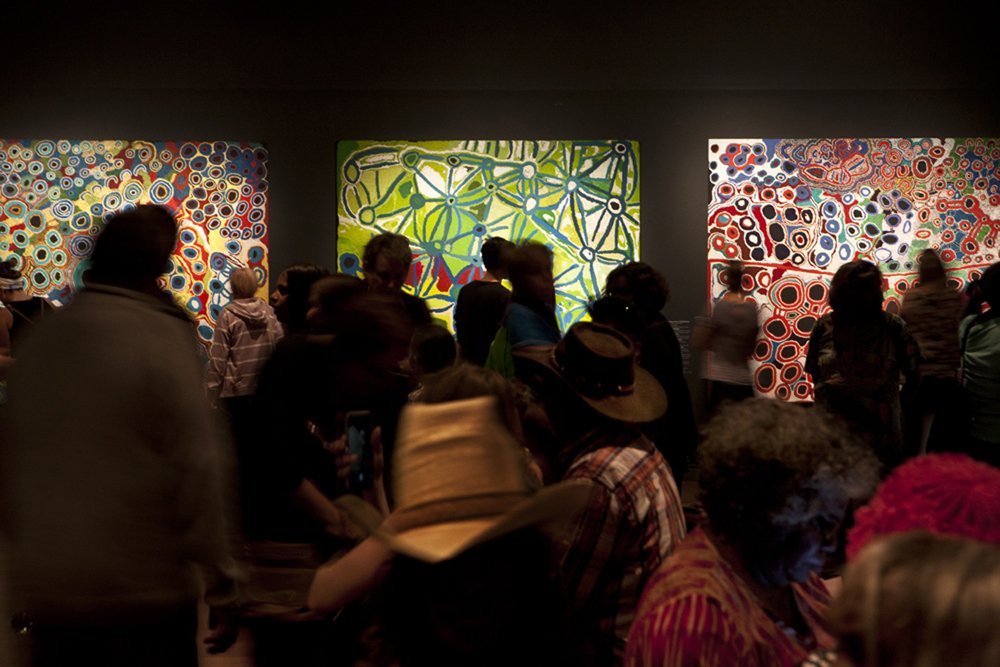
The opening night at Tarnanthi, the inaugural Festival of Contemporary Aboriginal and Torres Strait Islander Art in Adelaide in October 2015. Three hundred artists from across Australia contributed works to Tarnanthi (pronounced ‘tar-nan-dee’), which saw more then 50,000 people attending events in the South Australian capital. (Image credit: Frances Mocnik)
By showcasing contemporary Aboriginal art on a grand scale, the festival for the first time positioned work by urban artists telling contemporary interpretations of Dreaming stories, alongside that of community-based artists’ work from places rich in ancestral connections to country. This juxtaposition brought Dreaming stories into conversation in present time, where they combine with contemporary life and deliver the artist’s voice direct to the public.
A particular drawcard for young audiences at the festival was the street-art aesthetic of Reko Rennie. In his vibrant large-scale works, Rennie reinterprets symbols and mark-making to investigate personal identity and indigenous history and memory.
“Aboriginal art provides an awareness of a culture,” Rennie told me. “Here at Tarnanthi, it’s like you’re travelling through parts of Australia – you’re getting a cultural experience as well as seeing the diversity of cultural practices. Often [Aboriginal art] gets lumped into a mono-cultural identity when in reality it’s diverse… Politically we have a long way to go, but through the arts, that’s where change will come.”

Now in its 25th year, the annual Desert Mob exhibition at Alice Springs’ Araluen Arts Centre brings together the work of Aboriginal-owned Central Australia art centres and is one of the most important events on the Australian Aboriginal art calendar. Pictured here is With my shopping bags! by Marlene Rubuntja. (Image credit: Frances Mocnik)
By speaking in this way, Rennie has joined the ranks of fellow indigenous artists who create art with the power to raise the awareness of a country and effect change. When opening Tarnanthi, former prime minister Paul Keating said it was his hope that in the future “Aboriginal art will become so integral and so central to Australian art and representation that it will require no separate showing”.
With the international art world already championing the contemporary Aboriginal art movement, the invitation is now put to the Australian audience to join this celebration of artists whose work reaches through time, speaks of place and experience, and tells the story of our nation’s intersecting cultural histories.
How to ethically purchase Aboriginal art

Contemporary Aboriginal art fairs such as Adelaide’s Tarnanthi festival (above) provide an ethical platform to buy directly from artists or their art centres. Works ranged in price from $50 to $10,000 at the first Tarnanthi festival, which kicked off late last year. (Image credit: Frances Mocnik)
BUYING ETHICALLY produced and sold artwork supports fair trade practices and ensures profits reach artists, their art centres and communities. When buying art, ask first “Where has it come from?” advises Karyna Jansons, gallery assistant at Alice Springs’ Talapi Gallery. Understanding provenance should identify the artist, where art has been made and under what circumstances. A gallery, auction house or seller should provide information such as the artist’s language group and a description of the work’s creative or conceptual motivations (an ‘artist’s statement’). This should be in authenticity certificates accompanying works.
Buying art directly from Aboriginal-owned and -operated centres or affiliated galleries ensures ethical profit distribution. Aboriginal Art Fairs are also good places to buy. These curated events help art centres come together to sell direct to collectors, gallery owners and the general public. For more details see Purchasing Aboriginal Art – An Ethical Buying Guide, available to download at ankaaa.org.au.
Record-breaking sale
IN JULY 2007 Warlugulong by Clifford Possum Tjapaltjarri was bought by the National Gallery of Australia at a Sotheby’s auction for $2.4 million, smashing the record set two months earlier by Emily Kame Kngwarreye’s Earth’s Creation, which fetched $1.056 million. Given that Warlugulong was first bought in 1977 for $1200 by the Commonwealth Bank, its recent sale represented a 2000 per cent increase on the original price.
Although sales of individual documented Aboriginal artworks are well known, experts are finding it hard to place a value on the industry as a whole; even getting an accurate count on artist numbers is proving elusive. In a 2007 senate inquiry submission, ANU researcher Professor Jon Altman attributed this to disputes over definitions – what should or should not be included – and practical issues of data collection. He explained that looking at dollars returned to artists ($36 million) doesn’t reflect the overall value of the Aboriginal art industry, estimated in 2007 to be worth $400–500 million.
This article was originally published in the Mar-Apr 2016 issue of Australian Geographic (AG#131).
READ MORE:
- Why old theories on Indigenous counting just won’t go away
- Australia’s top 7 Aboriginal art rock sites
- World-first geonomic study of Aboriginal Australians
- Stan Grant’s “Racism is killing the Australian dream” speech




